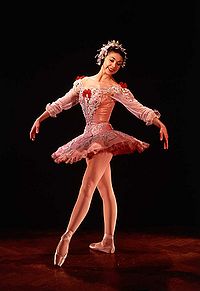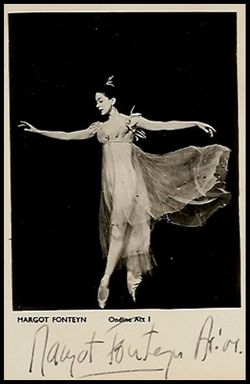Margot Fonteyn
| Dame Margot Fonteyn de Arias DBE | |
|---|---|
 Margot Fonteyn in 1974 |
|
| Born | Margaret Hookham 18 May 1919 Reigate, Surrey, United Kingdom |
| Died | 21 February 1991 (aged 71) Panama City, Panama |
| Cause of death | Cancer |
| Resting place | Panama |
| Nationality | British |
| Occupation | Ballerina |
| Employer | Royal Ballet |
| Known for | dancing |
| Title | Prima ballerina assoluta |
| Spouse | Roberto Arias |
Dame Margot Fonteyn de Arias, DBE (18 May 1919 – 21 February 1991), was an English ballerina of the 20th Century.[1] She is widely regarded as one of the greatest classical ballet dancers of all time. She spent her entire career as a dancer with the Royal Ballet, eventually being appointed Prima Ballerina Assoluta of the company by HM Queen Elizabeth II.
Contents |
Early life
Fonteyn was born Margaret Hookham on 18 May 1919 in Reigate, Surrey, to an English father and an Irish mother of Brazilian ancestry, who was the daughter of Brazilian industrialist Antonio Fontes. Early in her career, Margaret transformed Fontes into Fonteyn (a surname her brother adopted as well) and Margaret into Margot; thus her stage name. Her mother signed her up for ballet classes with her brother when they were young.
When she was eight she moved to Shanghai with her father who worked for a tobacco company there. She stayed in Shanghai, where she studied ballet with the Russian emigre teacher George Goncharov, for six years until her mother brought her back to London when she was 14. Her father stayed in Shanghai and was later interned by the invading Japanese force.
In 1933, she joined the Vic-Wells Ballet School, the predecessor of today's Royal Ballet School. She trained under the direction of Ninette de Valois and teachers including Olga Preobrajenska and Mathilde Kschessinska and later transferred to the Vic-Wells Ballet. She rose quickly through the ranks of the company, and by 1939, had performed principal roles in Giselle, Swan Lake and The Sleeping Beauty and was appointed Prima Ballerina.
Fonteyn was most noted in the ballets of Sir Frederick Ashton, including Ondine, Daphnis and Chloe, and Sylvia. She was especially renowned for her portrayal of Aurora in Tchaikovsky's The Sleeping Beauty. Televised versions of Sleeping Beauty and Ashton's version of Cinderella are now available on DVD. Fonteyn also worked with the choreographer Roland Petit and later in life, Martha Graham. In 1949, the Royal Ballet toured the United States and Fonteyn became an instant celebrity.
Dancing with Rudolf Nureyev and others
In the 1940s, she and Robert Helpmann formed a very successful dance partnership, and they toured together for several years. In the 1950s, she danced regularly with Michael Somes (they had first danced together in 1938, when they created Constant Lambert's Horoscope). But her greatest partnership emerged at a time when many (including the head of the Royal Ballet, Ninette de Valois) thought she was about to retire. In 1961, Rudolf Nureyev defected to the West, and on 21 February 1962 he and Fonteyn first appeared on stage together in a performance of Giselle. It was a great success; during the curtain calls Nureyev dropped to his knees and kissed Fonteyn's hand, cementing an on-and-offstage partnership which lasted until her 1979 retirement. Fonteyn and Nureyev became known for inspiring repeated frenzied curtain calls and bouquet tosses.
Ashton choreographed Marguerite and Armand for them, which no other couple danced until the 21st century. They debuted Kenneth MacMillan's Romeo and Juliet, although MacMillan had conceived the ballet for Lynn Seymour and Christopher Gable. Fonteyn and Nureyev appeared together in a film version of Swan Lake and Kenneth MacMillan's Romeo and Juliet, as well as Les Sylphides and the Le Corsaire Pas de Deux.

Despite their differences in background, temperament, and a nineteen-year difference in age, Nureyev and Fonteyn became close lifelong friends and were famously loyal to each other. Fonteyn would not approve an unflattering photograph of Nureyev. He said about her:
"At the end of Lac des Cygnes when she left the stage in her great white tutu I would have followed her to the end of the world."
The extent of their physical relationship remains unclear - Nureyev said that they had a physical relationship while Fonteyn denied it; her biographer agrees with Nureyev's version.[2] In 1967, they were arrested after a performance in San Francisco, when the police raided a Haight-Ashbury party to which they had been invited. They remained close even after she retired to a Panama cattle farm, talking on the phone several times a week even though her farmhouse did not have a telephone. When she was treated for cancer, Nureyev paid many of her medical bills and visited her often, despite his busy schedule as a performer and choreographer, as well as his own health problems (he was HIV positive and succumbed to AIDS in 1993). In a documentary about Fonteyn, Nureyev said that they danced with "one body, one soul" and that Margot was "all he had, only her." An observer said that "If most people are at level A, they were at level Z."
In the extremely competitive world of ballet, Fonteyn was renowned for her consummate professionalism and loyalty to her friends. Her dancing stood out for its lyricism, grace, and passion. Although Fonteyn was the Royal Ballet's biggest star, its director, Dame Ninette de Valois, cultivated other talents, so that the Royal Ballet of Fonteyn's day also included Nadia Nerina, Svetlana Beriosova, Lynn Seymour, and Antoinette Sibley.
Relationships
During the late 1930s and early 1940s, Fonteyn had a long relationship with composer Constant Lambert which did not lead to marriage. Lambert symbolised some aspects of this relationship in his ballet Horoscope (1938). In 1955, Fonteyn married Dr. Roberto Arias, a Panamanian diplomat to London and playboy. Their marriage was initially a rocky one due to his infidelities. She was arrested when he attempted a coup against the Panamanian government. In 1964, a rival Panamanian politician shot Arias, leaving him a quadriplegic for the rest of his life. Information released on 28 May 2010 indicated Dame Margot knew of, and at one point was involved in, the coup attempt.[3]
Fonteyn's career lasted until 1979, her sixtieth year, despite her suffering from an arthritic foot. Upon her retirement, the Royal Ballet honoured her with the title prima ballerina assoluta. She ended her days in Panama, remaining loyal to Arias in part because she was very devoted to his children from an earlier marriage. The Royal Ballet held a special "gala" in 1990 for her benefit. Shortly before his death, she was diagnosed with a cancer that proved fatal.
A dramatic image of her performing Swan Lake at the Bath Festival, Bath, United Kingdom, was captured by British photographer Des Gershon, taken secretly from the high gallery of the Theatre Royal, Bath, as she danced with the corps de ballet on the day she heard that there had been an attempt on the life of her husband. The stress, worry and pain is clearly shown in her face with the remarkable single frame of a moment in time.
Legacy

Fonteyn was awarded a DBE (made a dame) in 1956 at the age of 37.
She was chancellor of the University of Durham from 1981 to 1990. The main hall in Dunelm House, the Student Union building, is named the Fonteyn Ballroom in her honour.
Fonteyn died on 21 February 1991 in a hospital in Panama City, Panama.
Miscellany
Fonteyn provided the Introduction for Wushu! The Chinese Way To Family Health and Fitness [4] The book was translated for the Western market by Timothy Tung from a series of official handbooks published in China by The People's Sports Publishing House, Beijing.
Film and television
Fonteyn and Rudolf Nureyev starred together in a color film version of Swan Lake in 1967. under the guidance of the noted director Paul Czinner, they also filmed their famous version of Prokofiev's Romeo and Juliet in 1966.
Previously, Fonteyn had appeared with Michael Somes in a live U.S. television color production of Tchaikovsky's The Sleeping Beauty in 1955, for the anthology series Producers' Showcase, on NBC. This production has been preserved on black-and-white kinescope, and released on DVD. Later, on British television, Fonteyn starred again with Somes in a 1958 production of The Nutcracker (not to be confused with the live U.S. television production telecast by CBS on Playhouse 90).
A BBC film made in 2009, based on Daneman's biography and starring Anne-Marie Duff as Margot, aired on 30 November 2009.[5]
Main roles
- The Haunted Ballroom
- Cinderella
- Les Sylphides
- Don Juan
- Swan Lake
- Sylvia
- Apparitions
- The Firebird
- Aida
- Birthday Offering
- Ondine
- Night Shadow
- Horoscope
- Pomona
- Pelleas et Melisande
- The Judgement of Paris
- Beauty and the Beast
- The Sleeping Beauty
- Gayanch
- Carnaval
- The Dying Swan
- Lysistrata
- Romeo and Juliet
- Giselle
- Garden Party
- A Wedding Bouquet
- In Nightly Revels
- The Wanderer
- The Quest
- Hamlet
- Les Demoiselles de la nuit
- The Fairy Queen
- The Nutcracker
Quotations
- "The one important thing I have learned over the years is the difference between taking one's work seriously and taking one's self seriously. The first is imperative and the second is disastrous."
- "Great artists are people who find the way to be themselves in their art. Any sort of pretension induces mediocrity in art and life alike."
- "Life offstage has sometimes been a wilderness of unpredictables in an unchoreographed world."
- "Genius is another word for magic, and the whole point of magic is that it is inexplicable."
Cultural references
- Margot Fonteyn was one of five "Women of Achievement" selected for a set of British stamps issued in August 1996. The others were Dorothy Hodgkin (scientist), Marea Hartman (sports administrator), Elisabeth Frink (sculptor) and Daphne Du Maurier (writer)
References
- ↑ Obituary Variety, February 25, 1991.
- ↑ Meredith Daneman,Margot Fonteyn, Viking, 2004, ISBN 0-670-84370-9
- ↑ Bowcott, Owen (28 May 2010). "Dame Margot Fonteyn: the ballerina and the attempted coup in Panama". guardian.co.uk. http://www.guardian.co.uk/uk/2010/may/28/margot-fonteyn-panama-coup. Retrieved 28 May 2010.
- ↑ Mitchell Beazley Publishers 1981. ISBN 0-85533-315-4.
- ↑ John Preston (December 4th, 2009). "Margot, BBC Four, review". The Daily Telegraph. http://www.telegraph.co.uk/culture/tvandradio/6729235/Margot-BBC-Four-review.html.
External links
- Brief bio at Ballet.co.uk
- The Ballerina Gallery - Margot Fonteyn
- Margot Fonteyn at PeoplePlay UK
- Brief bio at Surrey Choicenet
- Brief bio at "My Hero" project
- Memories of Margo
| Academic offices | ||
|---|---|---|
| Preceded by Malcolm MacDonald |
Chancellor of the University of Durham 1981–1990 |
Succeeded by Sir Peter Ustinov |
|
|||||||||||||||||||||||||
